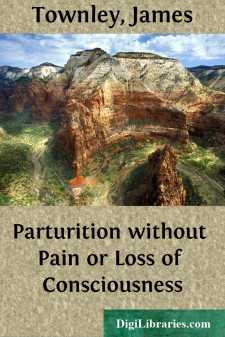Categories
- Antiques & Collectibles 13
- Architecture 36
- Art 48
- Bibles 22
- Biography & Autobiography 813
- Body, Mind & Spirit 142
- Business & Economics 28
- Children's Books 15
- Children's Fiction 12
- Computers 4
- Cooking 94
- Crafts & Hobbies 4
- Drama 346
- Education 46
- Family & Relationships 57
- Fiction 11829
- Games 19
- Gardening 17
- Health & Fitness 34
- History 1377
- House & Home 1
- Humor 147
- Juvenile Fiction 1873
- Juvenile Nonfiction 202
- Language Arts & Disciplines 88
- Law 16
- Literary Collections 686
- Literary Criticism 179
- Mathematics 13
- Medical 41
- Music 40
- Nature 179
- Non-Classifiable 1768
- Performing Arts 7
- Periodicals 1453
- Philosophy 64
- Photography 2
- Poetry 896
- Political Science 203
- Psychology 42
- Reference 154
- Religion 513
- Science 126
- Self-Help 84
- Social Science 81
- Sports & Recreation 34
- Study Aids 3
- Technology & Engineering 59
- Transportation 23
- Travel 463
- True Crime 29
Parturition without Pain or Loss of Consciousness
by: James Townley
Description:
Excerpt
PARTURITION WITHOUT PAIN.
For some time past, my attention has been directed to the use of anæsthetics in parturition. I had often been requested by patients to administer chloroform to them during labour, but I had seen the ill effects of this drug in one instance so strongly and almost fatally developed, that I shrank from its use. After considerable reflection on the subject, I thought that if a plan could be devised by which the anæsthetic agent should act only in deadening sensation, and not interfere with consciousness, it would be a boon to the accoucheur as well as to the patient. How was this to be effected? Two conditions appeared necessary for its accomplishment,—namely, a modification of the Inhaler at present in use; and certain additions to the chloroform—additions which would reduce its strength, and give it a certain flavour. These two conditions I had not much difficulty in fulfilling. But there arose an obstacle of more serious moment: How, when, and for what time, was the inhalation to be made? I will now give an account, seriatim, of my inhaler, the anodyne fluid which I employ, and the mode in which I direct the inhalation to be made.
The Inhaler is similar to one very commonly used in administering chloroform. It has, however, in addition, two tubes, an inch and a quarter long and a quarter of an inch in diameter, running parallel to the floor of the inhaler. These tubes, being placed above and to the sides of the inspiring valve, admit two small streams of fresh air, which to a great extent are inspired unmixed with the vapour of the anodyne. In the place of the grating there is a curved prong for retaining the sponge under the right tube and opposite the hole in the right side connected with the cup which receives the mixture to be inhaled. The object of this cup is—first, to receive the mixture, and direct it to the centre of the sponge. It has, in the second place, the advantage of helping to keep the Inhaler cool by the patient making use of it to rest her thumb upon when she is inhaling. It will therefore be gathered from this that the patient herself always holds the inhaler.
Manufactured by Messrs. Weiss and Son.
The anodyne mixture which I have found to be the most manageable is composed as follows: Alcohol, two ounces; one drachm of aromatic tincture; with sufficient chloroform added, short of the production of a turbid state of the fluid. The object of adding the tincture is to make it pleasanter to inhale; the spice also appears to prevent the sickness which would otherwise sometimes arise from long-continued inhalation. By giving a little colour to the mixture, also, it prevents any accident that might arise by putting in by mistake pure for the modified chloroform. I prepare the aromatic tincture as follows: One drachm of nutmegs; two drachms of cloves; pterocarp chips, a drachm and a half; water, four ounces; alcohol, five ounces: mix.
Mode of administering the anodyne vapour.—The great object to be attained is to so far influence the nerves of sensation as to prevent pain, and yet not carry the anæsthetic agent to the extent of producing unconsciousness....


